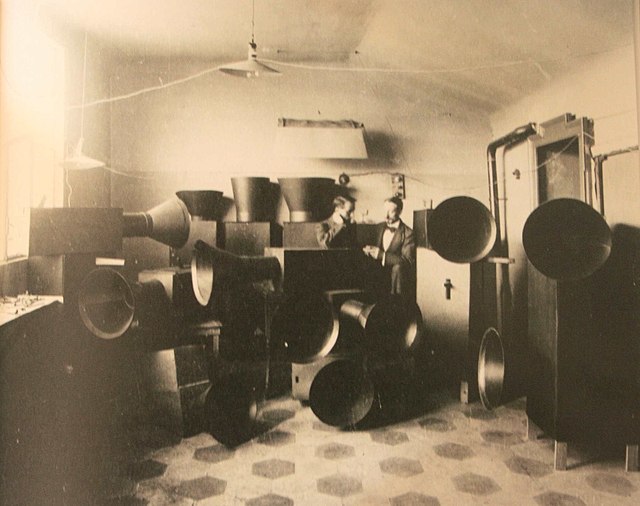Luigi Carlo Filippo Russolo was an Italian Futurist painter, composer, builder of experimental musical instruments, and the author of the manifesto The Art of Noises (1913). Russolo completed his secondary education at Seminary of Portograuro in 1901, after which he moved to Milan and began gaining interest in the arts. He is often regarded as one of the first noise music experimental composers with his performances of noise music concerts in 1913–14 and then again after World War I, notably in Paris in 1921. He designed and constructed a number of noise-generating devices called Intonarumori.
Russolo and his assistant Ugo Piatti in their Milan studio in 1913 with the Intonarumori (noise machines)
Souvenir d'une nuit (Memories of a Night), 1911 oil on canvas, 99 × 99 cm, private collection
Sintesi plastica dei movimenti di una donna, 1912 oil on canvas, Museum of Grenoble
Self-portrait with Skulls, 1909 painting
Futurism was an artistic and social movement that originated in Italy, and to a lesser extent in other countries, in the early 20th century. It emphasized dynamism, speed, technology, youth, violence, and objects such as the car, the airplane, and the industrial city. Its key figures included Italian artists Filippo Tommaso Marinetti, Umberto Boccioni, Carlo Carrà, Fortunato Depero, Gino Severini, Giacomo Balla, and Luigi Russolo. Italian Futurism glorified modernity and, according to its doctrine, "aimed to liberate Italy from the weight of its past." Important Futurist works included Marinetti's 1909 Manifesto of Futurism, Boccioni's 1913 sculpture Unique Forms of Continuity in Space, Balla's 1913–1914 painting Abstract Speed + Sound, and Russolo's The Art of Noises (1913).
Gino Severini, 1912, Dynamic Hieroglyphic of the Bal Tabarin, oil on canvas with sequins, 161.6 × 156.2 cm (63.6 × 61.5 in.), Museum of Modern Art, New York
Italian futurists Luigi Russolo, Carlo Carrà, Filippo Tommaso Marinetti, Umberto Boccioni and Gino Severini in front of Le Figaro, Paris, February 9, 1912
Umberto Boccioni, Unique Forms of Continuity in Space (1913)
Umberto Boccioni, sketch of The City Rises (1910)








